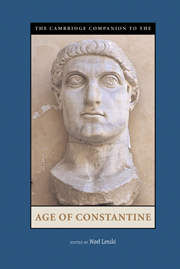Refine search
Actions for selected content:
23990 results in Ancient history
7 - Court and palace in ancient Egypt: the Amarna period and later Eighteenth Dynasty
-
-
- Book:
- The Court and Court Society in Ancient Monarchies
- Published online:
- 22 September 2009
- Print publication:
- 04 October 2007, pp 267-328
-
- Chapter
- Export citation
Frontmatter
-
- Book:
- The Court and Court Society in Ancient Monarchies
- Published online:
- 22 September 2009
- Print publication:
- 04 October 2007, pp i-iv
-
- Chapter
- Export citation
5 - The imperial court of the late Roman empire, C. AD 300–C. AD 450
-
-
- Book:
- The Court and Court Society in Ancient Monarchies
- Published online:
- 22 September 2009
- Print publication:
- 04 October 2007, pp 157-232
-
- Chapter
- Export citation
Notes on contributors
-
- Book:
- The Court and Court Society in Ancient Monarchies
- Published online:
- 22 September 2009
- Print publication:
- 04 October 2007, pp ix-x
-
- Chapter
- Export citation
Index
-
- Book:
- The Court and Court Society in Ancient Monarchies
- Published online:
- 22 September 2009
- Print publication:
- 04 October 2007, pp 354-358
-
- Chapter
- Export citation
Introduction
-
-
- Book:
- The Court and Court Society in Ancient Monarchies
- Published online:
- 22 September 2009
- Print publication:
- 04 October 2007, pp 1-16
-
- Chapter
- Export citation
2 - King, court and royal representation in the Sasanian empire
-
-
- Book:
- The Court and Court Society in Ancient Monarchies
- Published online:
- 22 September 2009
- Print publication:
- 04 October 2007, pp 58-81
-
- Chapter
- Export citation

The Cambridge Companion to the Age of Constantine
-
- Published online:
- 28 September 2007
- Print publication:
- 14 November 2005
Introduction
-
-
- Book:
- Religion, Dynasty, and Patronage in Early Christian Rome, 300–900
- Published online:
- 02 October 2009
- Print publication:
- 13 September 2007, pp 1-18
-
- Chapter
- Export citation
5 - Arabia between the great powers
-
- Book:
- Rome and Persia in Late Antiquity
- Published online:
- 05 June 2012
- Print publication:
- 13 September 2007, pp 152-172
-
- Chapter
- Export citation
Contents
-
- Book:
- Rome and Persia in Late Antiquity
- Published online:
- 05 June 2012
- Print publication:
- 13 September 2007, pp v-vii
-
- Chapter
- Export citation
Bibliography
-
- Book:
- Rome and Persia in Late Antiquity
- Published online:
- 05 June 2012
- Print publication:
- 13 September 2007, pp 282-325
-
- Chapter
- Export citation
Appendix 3 - Glossary
-
- Book:
- Rome and Persia in Late Antiquity
- Published online:
- 05 June 2012
- Print publication:
- 13 September 2007, pp 273-281
-
- Chapter
- Export citation
7 - Religion: Christianity and Zoroastrianism
-
- Book:
- Rome and Persia in Late Antiquity
- Published online:
- 05 June 2012
- Print publication:
- 13 September 2007, pp 210-231
-
- Chapter
- Export citation
PART III - RELIGION, DYNASTY, AND PATRONAGE
-
- Book:
- Religion, Dynasty, and Patronage in Early Christian Rome, 300–900
- Published online:
- 02 October 2009
- Print publication:
- 13 September 2007, pp 163-164
-
- Chapter
- Export citation
List of contributors
-
- Book:
- Religion, Dynasty, and Patronage in Early Christian Rome, 300–900
- Published online:
- 02 October 2009
- Print publication:
- 13 September 2007, pp xii-xiii
-
- Chapter
- Export citation
Index of place names
-
- Book:
- Rome and Persia in Late Antiquity
- Published online:
- 05 June 2012
- Print publication:
- 13 September 2007, pp 339-342
-
- Chapter
- Export citation
PART II - LAY, CLERICAL, AND ASCETIC CONTEXTS FOR THE ROMAN GESTA MARTYRUM
-
- Book:
- Religion, Dynasty, and Patronage in Early Christian Rome, 300–900
- Published online:
- 02 October 2009
- Print publication:
- 13 September 2007, pp 77-78
-
- Chapter
- Export citation
Abbreviations
-
- Book:
- Religion, Dynasty, and Patronage in Early Christian Rome, 300–900
- Published online:
- 02 October 2009
- Print publication:
- 13 September 2007, pp xiv-xvi
-
- Chapter
- Export citation
1 - From emperor to pope? Ceremonial, space, and authority at Rome from Constantine to Gregory the Great
-
-
- Book:
- Religion, Dynasty, and Patronage in Early Christian Rome, 300–900
- Published online:
- 02 October 2009
- Print publication:
- 13 September 2007, pp 21-58
-
- Chapter
- Export citation
